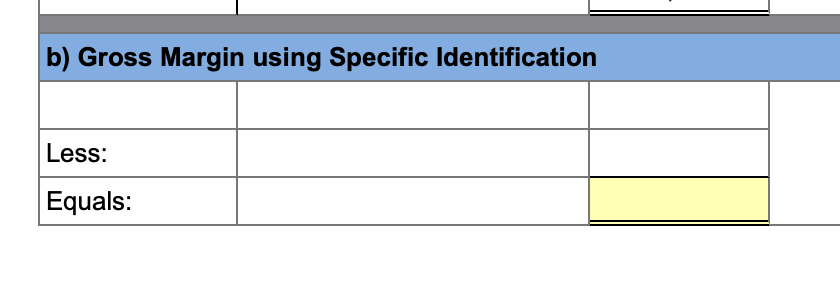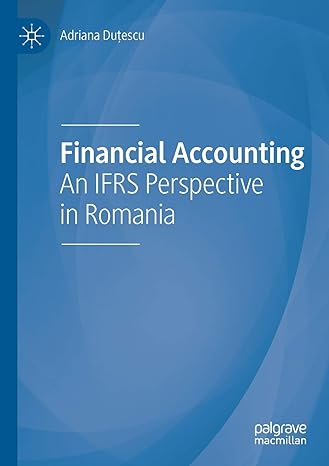Answered step by step
Verified Expert Solution
Question
1 Approved Answer
Ending inventory consists of 40 units from the March 14 purchase, 70 units from the July 30 purchase, and all 115 units from the October

Ending inventory consists of 40 units from the March 14 purchase, 70 units from the July 30 purchase, and all 115 units from the October 26 purchase. Using the specific identification method, calculate the following.

 Hemming Company reported the following current-year purchases and sales for its only product. \begin{tabular}{|c|c|c|c|c|c|c|c|} \hline Date & Activities & Units & quired at & cost & & Units Sold a & Retail \\ \hline January 1 & Beginning inventory & 215 units & (a) $10.60 & = & $2,279 & & \\ \hline January 10 & Sales & & & & & 180 units & @ $40.60 \\ \hline March 14 & Purchase & 320 units & @ $15.60 & = & 4,992 & & \\ \hline March 15 & Sales & & & & & 260 units & a $40.60 \\ \hline July 30 & Purchase & 415 units & a $20.60 & = & 8,549 & & \\ \hline October 5 & Sales & & & & & 400 units & a $40.60 \\ \hline October 26 & Purchase & 115 units & (a) $25.60 & & 2,944 & & \\ \hline & Totals & 1,065 units & & & $18,764 & 840 units & \\ \hline \end{tabular} b) Gross Margin using Specific Identification \begin{tabular}{|l|l|l|} \hline & & \\ \hline Less: & & \\ \hline Equals: & & \\ \hline \end{tabular} \begin{tabular}{|c|c|c|c|c|c|c|c|c|c|c|} \hline \multicolumn{11}{|c|}{ Answer is not complete. } \\ \hline \multicolumn{11}{|c|}{ a) Cost of Goods Sold using Specific Identification } \\ \hline \multirow[b]{2}{*}{ Date } & \multicolumn{3}{|c|}{ Available for Sale } & \multicolumn{4}{|c|}{ Cost of Goods Sold } & \multicolumn{3}{|c|}{ Ending Inventory } \\ \hline & Activity & \# of units & \begin{tabular}{l} Cost \\ Per \\ Unit \end{tabular} & \begin{tabular}{l} # of \\ units \\ sold \end{tabular} & \begin{tabular}{c} Cost Per \\ Unit \end{tabular} & & & \begin{tabular}{l} Ending \\ Inventory \\ Units \end{tabular} & \begin{tabular}{l} Cost Per \\ Unit \end{tabular} & \begin{tabular}{c} Ending \\ Inventory Cost \end{tabular} \\ \hline January 1 & Beginning Inventory & 215 & $10.60 & 0 & 10.60 & $ & 0 & 215 & 10.60 & 2,279 \\ \hline July 30 & Purchase & 415 & $20.60 & 0 & 20.60 & & 0 & 415 & 20.60 & 8,549 \\ \hline \multirow[t]{2}{*}{ October 26} & Purchase & 115 & $25.60 & 0 & 25.60 & & 0 & 115 & 25.60 & 2,944 \\ \hline & & 1,065 & & 0 & & $ & 0 & 1,065 & & 18,764 \\ \hline \end{tabular}
Hemming Company reported the following current-year purchases and sales for its only product. \begin{tabular}{|c|c|c|c|c|c|c|c|} \hline Date & Activities & Units & quired at & cost & & Units Sold a & Retail \\ \hline January 1 & Beginning inventory & 215 units & (a) $10.60 & = & $2,279 & & \\ \hline January 10 & Sales & & & & & 180 units & @ $40.60 \\ \hline March 14 & Purchase & 320 units & @ $15.60 & = & 4,992 & & \\ \hline March 15 & Sales & & & & & 260 units & a $40.60 \\ \hline July 30 & Purchase & 415 units & a $20.60 & = & 8,549 & & \\ \hline October 5 & Sales & & & & & 400 units & a $40.60 \\ \hline October 26 & Purchase & 115 units & (a) $25.60 & & 2,944 & & \\ \hline & Totals & 1,065 units & & & $18,764 & 840 units & \\ \hline \end{tabular} b) Gross Margin using Specific Identification \begin{tabular}{|l|l|l|} \hline & & \\ \hline Less: & & \\ \hline Equals: & & \\ \hline \end{tabular} \begin{tabular}{|c|c|c|c|c|c|c|c|c|c|c|} \hline \multicolumn{11}{|c|}{ Answer is not complete. } \\ \hline \multicolumn{11}{|c|}{ a) Cost of Goods Sold using Specific Identification } \\ \hline \multirow[b]{2}{*}{ Date } & \multicolumn{3}{|c|}{ Available for Sale } & \multicolumn{4}{|c|}{ Cost of Goods Sold } & \multicolumn{3}{|c|}{ Ending Inventory } \\ \hline & Activity & \# of units & \begin{tabular}{l} Cost \\ Per \\ Unit \end{tabular} & \begin{tabular}{l} # of \\ units \\ sold \end{tabular} & \begin{tabular}{c} Cost Per \\ Unit \end{tabular} & & & \begin{tabular}{l} Ending \\ Inventory \\ Units \end{tabular} & \begin{tabular}{l} Cost Per \\ Unit \end{tabular} & \begin{tabular}{c} Ending \\ Inventory Cost \end{tabular} \\ \hline January 1 & Beginning Inventory & 215 & $10.60 & 0 & 10.60 & $ & 0 & 215 & 10.60 & 2,279 \\ \hline July 30 & Purchase & 415 & $20.60 & 0 & 20.60 & & 0 & 415 & 20.60 & 8,549 \\ \hline \multirow[t]{2}{*}{ October 26} & Purchase & 115 & $25.60 & 0 & 25.60 & & 0 & 115 & 25.60 & 2,944 \\ \hline & & 1,065 & & 0 & & $ & 0 & 1,065 & & 18,764 \\ \hline \end{tabular} Step by Step Solution
There are 3 Steps involved in it
Step: 1

Get Instant Access to Expert-Tailored Solutions
See step-by-step solutions with expert insights and AI powered tools for academic success
Step: 2

Step: 3

Ace Your Homework with AI
Get the answers you need in no time with our AI-driven, step-by-step assistance
Get Started


